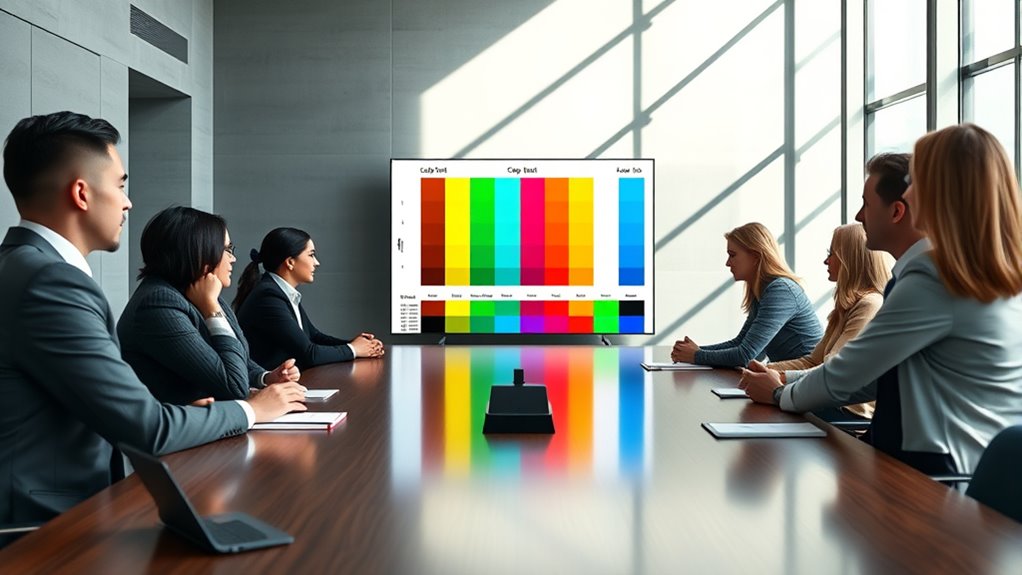Using color tests in the workplace can give you quick insights into employee traits and help with team dynamics, decision-making, and role assignments. They’re simple tools that support communication and collaboration when used thoughtfully. However, they also risk oversimplifying complex personalities, reinforcing stereotypes, or leading to biases if relied on too heavily. If you want to understand how to balance their benefits with limitations, keep exploring these important points.
Key Takeaways
- Color tests provide quick insights into personality traits, aiding rapid decision-making in team management.
- They can oversimplify complex behaviors, risking stereotypes and limiting individual growth.
- Using color tests as the sole basis for decisions may lead to unfair biases and overlook employee potential.
- Properly applied, they enhance communication, role alignment, and team dynamics when combined with comprehensive assessments.
- Caution is necessary to prevent reliance on labels that may misrepresent nuanced human personalities and behaviors.

Color tests are increasingly popular tools in workplace settings, but their effectiveness and fairness remain subjects of debate. When you use these tests to evaluate employee personality, you might gain quick insights into individual traits, but you also risk oversimplifying complex human behaviors. Many managers believe that understanding employee personality through color-coded results can help improve team dynamics, foster better communication, and assign roles that align with personal strengths. For example, someone identified as a “red” might be seen as a natural leader, while a “blue” could be viewed as detail-oriented and thoughtful. Such labels can provide a helpful shorthand for understanding how different team members might interact and contribute, but they can also pigeonhole employees, limiting their growth and overlooking their multifaceted nature.
One advantage of using color tests is that they offer a straightforward way to categorize and analyze personality differences quickly. This can streamline decision-making around team composition and project assignments. When you understand the general tendencies of your team members, you might find it easier to foster collaboration by pairing complementary personalities or balancing out potential conflicts. However, this approach can be problematic if you rely too heavily on color labels, ignoring the nuance and context that shape an individual’s behavior. People are complex, and their personality traits can shift over time or vary based on circumstances. Reducing someone to a specific color might lead you to make assumptions that aren’t entirely accurate, which can harm team cohesion and morale. Additionally, incorporating industry trends can help ensure that team assessments remain relevant and effective.
Furthermore, using color tests raises questions about fairness and bias. If you base important decisions—like promotions, leadership opportunities, or task assignments—on color-coded results, you risk unfairly favoring or disadvantaging certain employees. These tests can also reinforce stereotypes, especially if managers interpret the results through their own biases. For you, this means being cautious about how much weight you give to these tests and ensuring that they supplement, rather than replace, a more thorough understanding of each employee’s capabilities and potential. Ultimately, while color tests can serve as a helpful tool for understanding employee personality and team dynamics, they shouldn’t be the sole basis for critical workplace decisions. Used thoughtfully, they can enhance communication and teamwork, but misused or over-reliant upon, they can create division and misjudgments.
Frequently Asked Questions
Are Color Tests Scientifically Validated for Employee Assessment?
You should know that color tests lack robust scientific validation for employee assessment. Validity concerns arise because these tests often don’t measure job-related traits reliably. Additionally, cultural biases can skew results, making them unfair across diverse workplaces. While some companies use them for quick insights, you shouldn’t rely solely on color tests for vital hiring decisions, as their scientific credibility remains questionable.
How Do Color Tests Compare to Traditional Interview Methods?
You find that color tests offer quick personality insights, but they can be less reliable than traditional interviews. While they may reveal some traits, cultural biases might skew results, making them less accurate for diverse teams. Unlike interviews, which allow for nuanced understanding through conversation, color tests often oversimplify personalities. Use them as a supplement, not a replacement, to get a fuller picture of a candidate’s abilities and fit.
Can Color Tests Predict Job Performance Accurately?
Studies show that personality insights from color tests can predict job performance around 50-60% of the time, but they aren’t foolproof. You might find these tests helpful for understanding traits, yet cultural biases can skew results, making predictions less accurate. While they offer quick insights, rely on them alongside traditional assessments to get a more complete picture of how well someone will perform in the role.
What Are the Legal Implications of Using Color Tests?
Using color tests in the workplace can raise legal compliance issues, especially if they lead to discrimination or bias. You need to make sure that your use of these tests respects privacy concerns and adheres to employment laws. Avoid infringing on candidate or employee rights by clearly explaining how the tests are used and obtaining proper consent. Failing to do so could result in legal challenges or claims of unfair treatment.
How Do Employees Generally Perceive Color Testing in Hiring?
You might find that employees often view color testing with mixed feelings, seeing it as a subtle perception challenge that could highlight bias concerns. Some appreciate the insight into personality traits, while others worry it might unfairly influence hiring decisions. Overall, many perceive it as a tool that offers value but also carries risks of misinterpretation. Remaining transparent and sensitive can help ease concerns and foster trust in the process.
Conclusion
As you navigate the vibrant tapestry of the workplace, color tests can be your guiding palette—highlighting strengths and revealing blind spots. But remember, just like mixing paints, overreliance can muddy the picture. Use these tools wisely, blending intuition with insight. When you do, you’ll craft a workspace painted with understanding, where every hue discloses a new layer of potential, turning the ordinary into a masterpiece of collaboration and growth.
Felicity, our Author, pens in-depth articles and guides that delve into the heart of personal discovery. Her narrative-driven approach weaves together theory, practice, and personal anecdotes, making the journey of self-exploration both relatable and inspiring. Felicity’s contributions help illuminate the path for those seeking a deeper understanding of themselves and their relationships.









